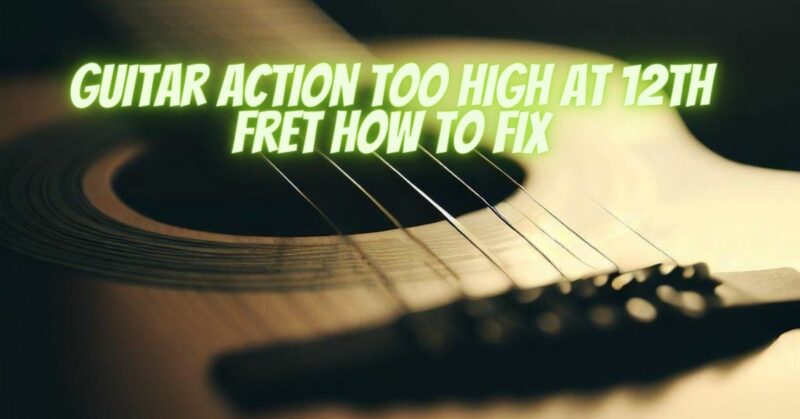High action at the 12th fret of a guitar can be a frustrating obstacle for any guitarist. It affects playability, intonation, and overall enjoyment while playing. However, with a bit of knowledge and patience, you can address this issue and achieve an ideal setup. In this article, we will discuss why high action at the 12th fret occurs and provide a step-by-step guide on how to fix it, allowing you to enjoy playing your guitar to the fullest.
Understanding High Action at the 12th Fret
Action height on a guitar refers to the distance between the strings and the fretboard. High action specifically at the 12th fret means that the strings are positioned too far from the fretboard at this point. Several factors can contribute to this problem:
- Neck Relief: The curvature of the guitar neck, known as neck relief or bow, plays a significant role in action height. If there’s too much bow in the neck, it can result in high action at the 12th fret.
- Bridge Saddle Height: The height of the bridge saddle, especially in the vicinity of the 12th fret, affects action. If the saddle is too high or uneven, it can lead to high action.
- Nut Height: The nut, where the strings meet the headstock, can also influence action at the 12th fret. An improperly cut or worn nut may elevate the strings in this area, causing high action.
Consequences of High Action at the 12th Fret:
High action at the 12th fret can cause various issues:
- Difficult Chord Fretting: High action makes it challenging to fret chords accurately, leading to finger fatigue and discomfort.
- Intonation Problems: Incorrect action at the 12th fret can disrupt the guitar’s intonation, causing it to play out of tune when you move up the neck.
- Fret Buzz: To compensate for high action, guitarists may press the strings harder, resulting in fret buzz and an unpleasant playing experience.
- Tone and Sustain Loss: High action can negatively impact the guitar’s tone and sustain, as the strings may not vibrate optimally when positioned too far from the fretboard.
How to Fix High Action at the 12th Fret:
Here’s a step-by-step guide on how to fix high action specifically at the 12th fret on your guitar:
Step 1: Measure the Action
Use a ruler or feeler gauges to measure the action height at the 12th fret. This measurement serves as a reference point for your adjustments.
Step 2: Examine Neck Relief
Check the curvature of the guitar neck to assess neck relief. If you find excessive forward bow, consider adjusting the truss rod. Consult your guitar’s manufacturer guidelines or seek assistance from a professional technician for truss rod adjustments.
Step 3: Adjust the Bridge Saddle:
To lower the action specifically at the 12th fret:
- Remove the strings to access the saddle.
- Carefully sand or file down the saddle to reduce its height around the 12th fret area. Ensure that you maintain a flat and even surface.
- Reinstall the saddle, restring the guitar, and tune it up.
Step 4: Check and Adjust Intonation:
After lowering the action, revisit the intonation to ensure that each string plays in tune along the entire fretboard. Make any necessary adjustments to the saddle positions.
Step 5: Inspect Nut Height:
Examine the nut to ensure it is properly cut and not excessively high around the 12th fret area. If necessary, consult a professional technician or luthier to address nut height issues.
Step 6: Play and Assess:
Play your guitar to assess the action height, playability, tone, and intonation, specifically at the 12th fret. Make additional adjustments if needed to achieve your desired setup.
Fixing high action at the 12th fret is crucial for ensuring an enjoyable and comfortable playing experience on your guitar. By following these steps and making precise adjustments, you can ensure that your guitar’s action is consistent and ideal across all frets. Remember that achieving the perfect setup may require some experimentation, so take your time and listen to how each adjustment impacts your guitar’s performance. If you’re uncertain about any steps or encounter challenges during the process, consider seeking assistance from a professional guitar technician or luthier to ensure your guitar plays at its best.


